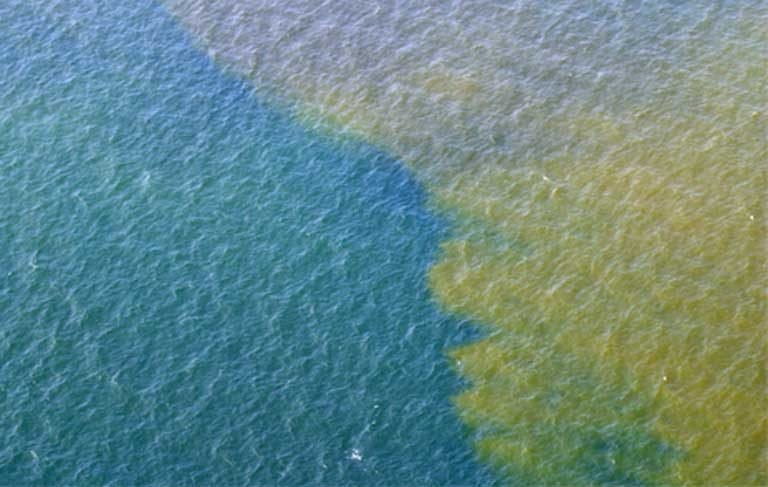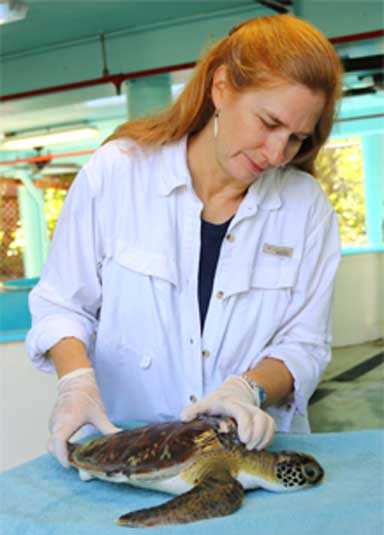- Harmful algal blooms (HABs), dubbed “red tides,” occur worldwide. When ingested, tiny, toxin-producing algae threaten marine and human life. These events — sometimes natural, but often human-induced — now happen annually on the U.S. Gulf Coast and kill endangered turtle species.
- Physiologist Sarah Milton, at Florida Atlantic University, researches the effect of HABs on freshwater turtles to improve treatment for endangered sea turtles that are rescued from toxin-filled waters.
- Milton found that pond turtles tolerate far more algal toxin than similar sized mammals can survive — resistance possibly rooted in their ability to dive, living without oxygen for months. Understanding this ability could help sickened sea turtles rescued during harmful algal outbreaks.
- Understanding the cellular mechanisms that allow pond turtles to maintain brain and body function during anoxic conditions could also help scientists improve outcomes for people who have suffered oxygen-deprivation events, such as stroke, which trigger irreversible brain cell death.

Beneath their prehistoric-looking shells, turtles conceal an extraordinary ability to hold their breath underwater, going without oxygen for hours, even months, at a time. This cellular-level capacity to survive underwater also helps turtles resist the effects of environmental pollution from harmful algal blooms (HABs), toxic events also commonly dubbed “red tides,” according to studies by physiologist Sarah Milton and her colleagues at Florida Atlantic University.
A better understanding of how these red tide toxins affect freshwater turtles could help researchers develop better treatment protocols for sickened sea turtles that are rescued during harmful algal outbreaks.
Harmful algal blooms — appearing as red tides or in other colors — occur with the rapid uncontrolled growth of algae in freshwater or marine environments. The alga uses up the water’s oxygen, making it anoxic, while also producing toxins. These events — sometimes naturally caused, but also brought on by increased nutrient loading due to chemical fertilizers and other human activities — have become an annual event on the U.S. Gulf Coast, killing endangered sea turtles, manatees, dolphins, fish and countless other marine life.
As the world’s waters become warmer due to climate change, and as human activities add more pollutants, especially nitrates and phosphorus from agricultural runoff, harmful algal blooms are going global, with frequently lethal effects on sea creatures.
Milton’s red tide research focuses on brevetoxin, one group of neurotoxins made by a single-celled dinoflagellate called Karenia brevis. In people, these toxins are known for causing shellfish poisoning or severe asthma attacks. Although studies in mammals have shown that brevetoxins disrupt nerve function, causing muscle and brain damage, no baseline information existed for turtles. “We didn’t know if the toxin worked the same way in turtles, what amounts caused damage, or how turtles cleared it from their system,” said Milton.

Compared with similarly sized mammals, turtles have a slow metabolism, which makes them susceptible to drug effects at smaller amounts. So Milton expected that it wouldn’t take very much toxin to sicken freshwater turtles if exposed to a simulated red tide. Surprisingly, these turtles turned out to be more resistant than expected to high toxin levels.
Milton suspects that the turtles’ resistance to red tide toxins is related to their ability to make long dives that deprive their brains of oxygen for up to weeks at a time;as in mammals both the toxin and oxygen deprivation kill cells by a common pathway. Several investigators are studying what enables turtle cells to operate without oxygen, and then return to normal function.
Understanding how the toxin affects freshwater turtles could improve treatment strategies for HAB-exposed sea turtles, and possibly for people suffering from anoxic and/or toxic conditions. Additional studies may reveal what tips the turtles’ cell toward survival, knowledge that could offer insight into the brain cell death that occurs when humans suffer strokes.

Mongabay: What prompted your research into “red tide” effects on turtles?
Milton: It started from my interest in environmental physiology. Anoxia is one big area of study, and turtles can stay under water for hours at a time: how do their brains survive without oxygen?
But you can’t study sea turtles because they’re all endangered, so I work with freshwater turtles which turn out to be even better at holding their breath; they can survive an entire winter of hibernating, essentially not breathing for months.
Turtle physiology — their immune system — can also be impacted by environmental pollution. In Florida, the Indian River Lagoon estuary has very high nutrient loads from agricultural runoff, and the green turtles there have a high incidence of papilloma viral disease. In a pristine area nearby, turtles have zero disease. The algal blooms are another aspect of this because they are also fueled by increasing waterway pollution with nutrient runoff.
Red tides can cause very large die-offs. On the west coast of Florida, in 2005, more than 300 sea turtles plus fish, manatees, and dolphins died from an algal bloom. Not all the animals die, though. Some turtles get rescued and taken to rehabilitation facilities for treatment where the main focus is ameliorating the toxin’s symptoms and trying to clear it out of their system faster. But we don’t know what the toxin actually does, so it’s very hard to design good treatment protocols.
So the goal was to use common freshwater turtles (Trachemys scripta) as a model, to understand what organs the toxin affects, how quickly it clears from their systems, the effects on the immune system, and the toxin mechanism in the cells. The real question was: are turtles affected by brevetoxin in the same way as mammals?
While essentially a brain is a brain, and a muscle is a muscle, regardless of the animal, previous studies had only been done in mammals. And turtles have a much slower metabolic rate, so toxins might not move as quickly through their bodies. Or maybe that slow metabolism, relative to mammals, might make the toxin worse because turtles couldn’t clear it as quickly.

Mongabay: So, do turtles have special pathways that protect their cells?
Milton: We haven’t yet found anything truly unique to turtles. Even mammal brains have protective mechanisms to resist cell death after a stroke or heart attack. But, in a tug of war between survival and death pathways, the death pathways win in mammals. For turtles, though, the death pathways are very strongly suppressed and the protective pathways are very strongly up-regulated.
We think that the mechanisms that protect turtle brain cells against dying when [the animal] doesn’t have enough oxygen are similar to the mechanisms that keep the brain from dying from toxin. The two pathways are very similar and when the toxin reaches high enough levels, both mammals and turtles show the same symptoms.
For instance, the pond turtles we studied — as well as sea turtles examined in rehab centers — become very uncoordinated, they have muscle spasms and head bobbing, and they circle in the water, similar to what mammals would do on land. But we didn’t know that before, because scientists had only studied the toxin’s effects on mammals.
Now that we know, we can design more effective treatments for sea turtles. Right now, treatments are aimed at supportive care for animals exposed to brevetoxins. With better understanding of this toxin’s impact on turtles, we can design strategies that clear the toxin out of their systems more quickly and also draw out the toxin from tissues.

Mongabay: What surprised you about brevetoxin’s effect in turtles?
Milton: We used brain cell cultures to study the mode of action in turtles compared with mammals. Once we knew the toxin worked the same way — it props open sodium channels in cells, leading to continuous depolarization until the cell dies — we then wanted to know the “effective doses” of toxin. How much toxin did it take to cause cell problems?
We found that pond turtle brain cells are highly resistant to the toxin; more than 16-fold more resistant than mammal cells, even when we repeated the tests at temperatures that were closer to normal for mammals. [Turtles are reptiles, which, unlike mammals, don’t maintain a specific core body temperature, but internal temperature can vary with environmental temperatures.]
That was surprising because typically when we’re translating mammalian studies into anything with turtles, we figure that a turtle has only one-tenth the normal metabolic rate of a mammal. And then about half of that is shell. So, if we’re doing some treatment we’d use one-tenth, to one-twentieth, the dose we’d use to get the same effect in a mammal.

We also found that pond turtles [in live animal studies] could quickly clear the toxin from their systems over a period of 24 to 48 hours, for both oral and inhaled exposures. That’s not the case at rehab centers where blood testing on sea turtles showed they could take up to 80 days before getting toxins cleared.
Algal toxins may persist in the water, in plants or other food sources, making turtles more susceptible to disease or other environmental stressors in the long term. So when these animals [sea turtles] are coming in for rehab and are sick, they must have been exposed to massive doses of toxin for an extremely long time.
We’re working out new treatment protocols for sea turtles now. But we’re also still studying the mechanisms that enable turtles to go so long without oxygen. With turtles’ survival skills, the question is: how can we help human brain cells become more like turtles?”
For more on the topic:
Cocilova CC, Flewelling LJ, Bossart GD, Granholm AA, Milton SL. Tissue uptake, distribution and excretion of brevetoxin-3 after oral and intratracheal exposure in the freshwater turtle Trachemys scripta and the diamondback terrapin Malaclemys terrapin. Aquatic Toxicology (2017) March; 187: pp 29-37.
Cocilova CC, Milton SL. Characterization of brevetoxin (PbTx-3) exposure in neurons of the anoxia-tolerant freshwater turtle (Trachemys scripta). Aquatic Toxicology (2016) Nov;180: pp 115-122.
Milton SL, Prentice HM. Beyond Anoxia: The Physiology of Metabolic Downregulation and Recovery in the Anoxia-tolerant Turtle. Comparative Biochemistry and Physiology, Part A, Molecular & Integrative Physiology. (2007) June; 147(2): pp 277-290.
Nayak G, Prentice HM, Milton SL. Lessons from nature: Signaling cascades associated with vertebrate brain anoxic survival. Experimental Physiology (2016) Mar 17. [Epub ahead of print]
FEEDBACK: Use this form to send a message to the author of this post. If you want to post a public comment, you can do that at the bottom of the page.
